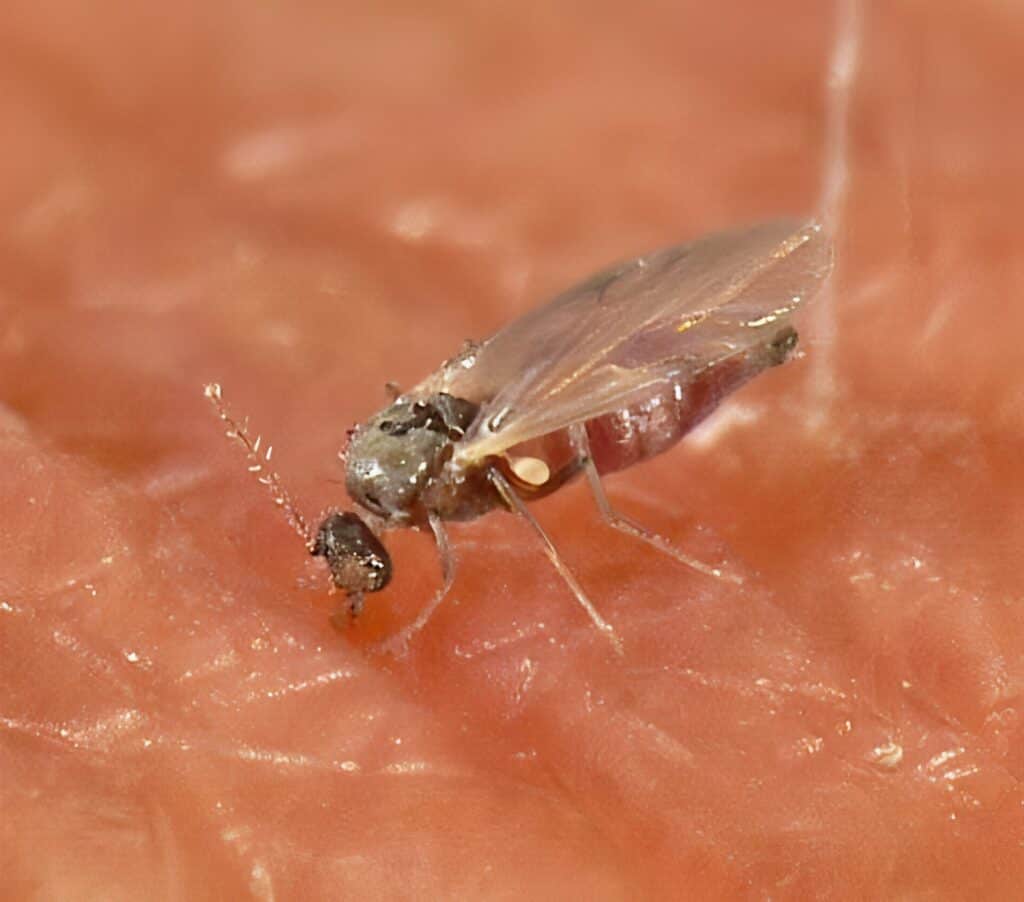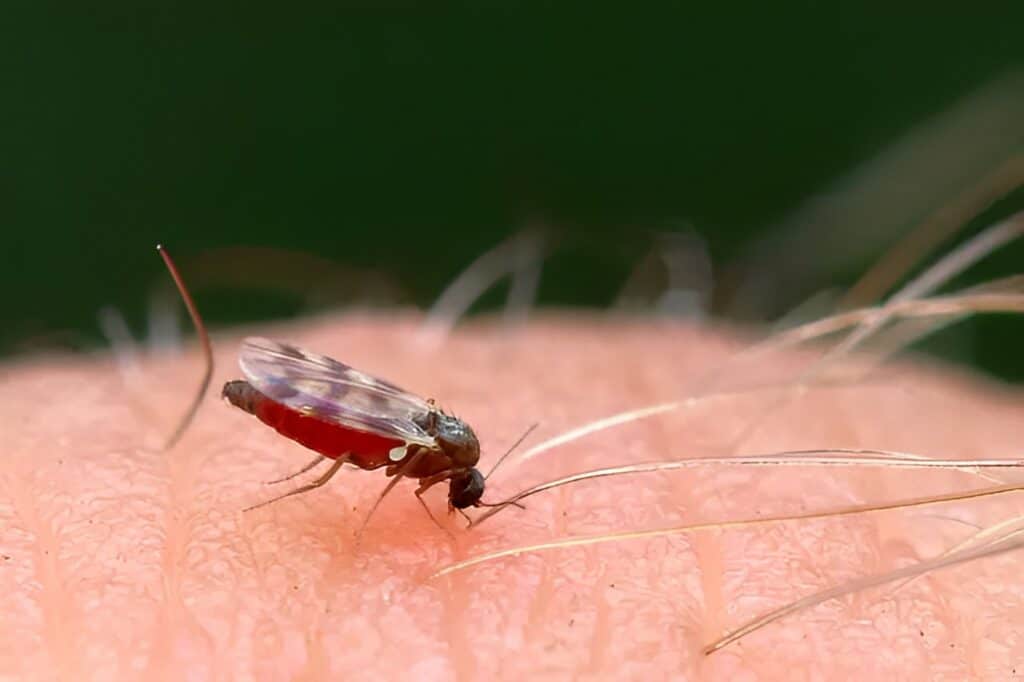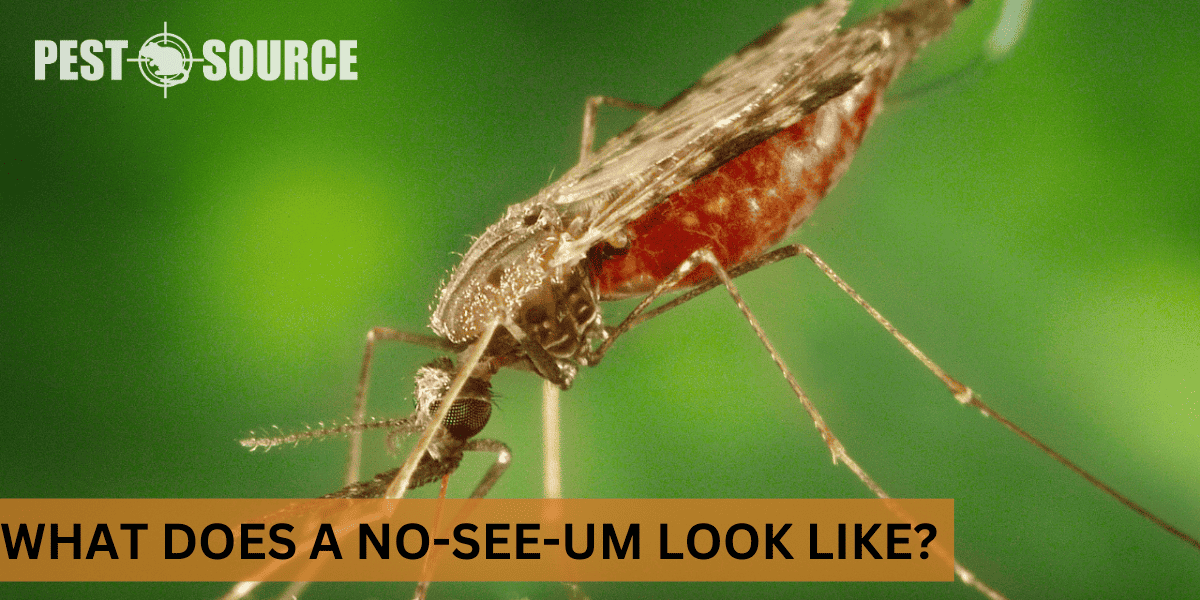If you’ve ever been outdoors on a summer evening and found yourself repeatedly itching, you’ve possibly encountered the notorious no-see-ums. Their bites are sudden, and their presence are practically undetectable. Despite their tiny size, their impact on our comfort can be massive.
In this guide, we’ll delve into intricate details about what a no-see-um looks like, their unique characteristics, why it’s so important to recognize them, and tips to prevent them from turning your vicinity into their playground.
POINTS
- No-see-ums, also known as biting midges, sandflies, punkies, and sand gnats, are tiny insects, measuring between 1/16 to 1/8 inch in length, with gray to black bodies that make them difficult to see with the naked eye.
- Key identifying features of no-see-ums include their unique wings covered with dense hair that create pigmented patterns, large compound eyes, and antennae with 15 segments.
- Their large compound eyes allow for a wider field of view, helping them avoid predators and seek out food. The segmentation in their antennae aids in sensory capabilities and plays a vital role during the mating season.
- The bite of a no-see-um can cause uncomfortable itches and potentially serious allergies in humans. They can also transmit diseases such as the Blue Tongue Virus to pets and livestock.
- Prevention methods against no-see-ums include the installation of fine mesh screens, regular cleaning of surroundings, use of insect repellents and bug zappers, and seeking professional pest control assistance when necessary.
What Are No-See-Ums and Why Are They Named So?
What are no-see-ums and their common names?
No-see-ums, scientifically known as ‘Ceratopogonidae‘, are a group of insects within the biting midge family. They’re infamous for their irritable bites and are also commonly referred to as sandflies, punkies, and sand gnats.
Where does the no-see-um name come from?
The name ‘no-see-um’ is a colloquialism rooted in the American South, essentially describing the insects’ minuscule size and their stealthy nature. These pesky creatures are so tiny that they often go unnoticed until they bite, hence the name.
What does a no-see-um look like?

Small but mighty is the perfect phrase for no-see-ums. Roughly measuring between 1/16 to 1/8 inch long, no-see-ums possess gray or black bodies and are generally difficult to see with the naked eye. Despite their negligible size, their nuisance value is unmistakably substantial, thanks to their threatening bite.
What is the Size and Structure of a No-See-Um?
What is the size of no-see-ums?

On average, no-see-ums measure roughly between 1/16 to 1/8 inch in length. Their physical structuring, combined with their minuscule size, makes them truly challenging to spot with unaided eyes.
What makes them difficult to see with the naked eye?
Part of the reason no-see-ums are so challenging to detect comes down to their tiny stature. The typical no-see-um is smaller than a fruit fly, and their gray or black bodies blend in well with many outdoor elements, essentially cloaking them until they’re ready to strike.
What Are the Key Identifying Features of a No-See-Um?
How would one describe the body color of no-see-ums?

No-see-ums present themselves with gray to black-colored bodies. This coloring not only provides them with a natural camouflage against many outdoor backdrops but also contributes to their near-invisibility to our eyes.
What distinctive features do their wings have?

One of the key identifying features of no-see-ums is their wings. They are covered with dense hair, creating unique pigmented patterns which can be visible under a good-quality magnifying glass or microscope.
How do these wings help in identifying them?
These wing patterns are critical to identifying no-see-ums accurately. Different species of no-see-ums have variations in their wing patterns, and these characteristics are frequently used by entomologists to classify and identify the different species within the no-see-ums family.
How Do the Eyes and Antennae of No-See-Ums Differ from Other Insects?
What eyes do no-see-ums have?
No-see-ums have a remarkable pair of large, compound eyes. These eyes, which are made up of many small, closely packed lenses, give them a fairly comprehensive view of their surroundings.
How do these eyes differ from those of other similar-sized insects?
While many small insects have compound eyes, what sets no-see-ums apart is their size concerning their body — their eyes are exceptionally large. This feature is not common among other insects of similar size and allows no-see-ums a more extensive visual range.
What are the functionalities or advantages, if any, of having such eyes?
Large compound eyes give no-see-ums an advantage in the wild. They allow for a wider field of vision, helping them evade prospective predators and also seek out food (or, in our human-centric case, targets for their bites).
How many segments do no-see-um antennae have and how does this distinguish them?
No-see-ums’ antennae are generally comprised of 15 segments, another distinguishing feature of these insects. The segmented feature allows for greater sensory perception, beneficial in locating food sources or attracting mates.
What is the difference of no-see-ums antennae with other insects and what is its significance?
While many insects possess segmented antennae, few show the same number of divisions as the no-see-um. This extensive segmentation aids in their sensory capabilities, and as in the case of male no-see-ums, these antennae also play a vital role in finding their female counterparts during the mating season.
How Do No-See-Ums Compare to Other Small Insects?
How are no-see-ums different from other similar insects?
No-see-ums, despite their small size, are unique in several ways. From their large compound eyes, extensive antenna segmentation, to unique wings with pigmented patterns, no-see-ums stand out in the insect world.
How can one identify a no-see-um among other insects?
Identifying a no-see-um among the myriad of small insects could be a tricky task. A good place to start is to look for their distinguishing features — gray to black bodies, unique pigmented wing patterns, and large compound eyes. However, your best bet is to seek professional help for accurate identification.
Why is it Important to Recognize a No-See-Um?
What are the potential harm that no-see-um bites might cause?
The bite of a no-see-um can cause uncomfortable itches and potentially serious allergies in humans. Their bites can be ever more harmful to pets and livestock, transmitting diseases such as Blue Tongue Virus.
Where are no-see-ums commonly found?
No-see-ums thrive in damp, swampy, and woody spaces, but they are also commonly found in our homes, particularly around our yards, due to their small size which allows them to pass through ordinary window screens. Therefore, correctly identifying a no-see-um is essential to protect you, your family, and even pets from their harmful impacts.
How to Prevent a No-See-Um Invasion?
Preventing no-see-ums from making your home their breeding ground is vital for your comfort and health. Here are some practical strategies:
Install fine mesh screens
Standard window screens may not suffice to keep these tiny culprits at bay. Incorporate mesh screens with smaller holes in your windows and entrances to prevent them from finding a path into your home.
Regularly clean your surroundings
No-see-ums are drawn to damp and dirty spaces. Regularly cleaning potential breeding grounds like puddles, plant pots, or gutters assists significantly in reducing their numbers.
Use repellents and bug zappers
Consider using insect repellents designed to deter no-see-ums. Bug zappers may also prove useful in controlling their population, especially in outdoor spaces.
Seek professional help
When all else fails, it’s best to consider reaching out to pest control professionals. They possess the knowledge and tools required to handle severe infestations effectively.
Conclusion
While no-see-ums may be tiny, they are potent pests that should not be underestimated. Knowing their unique features— from their gray to black bodies and distinct wing patterns to their large compound eyes and segmented antennae— equips you with the knowledge to identify and control these tricky invaders, ensuring a safer, bite-free environment.



